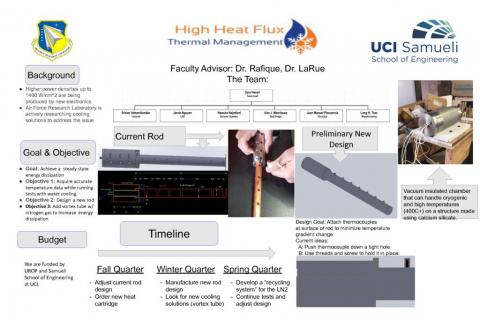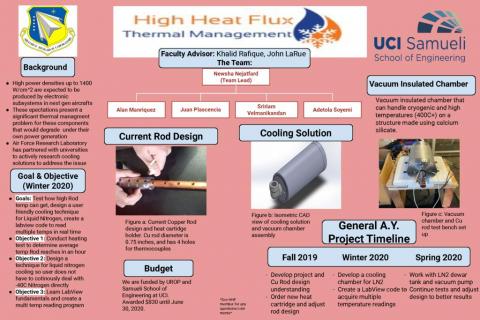High Heat Flux Thermal Management
Advances in electronic components will increasingly produce higher power densities. A select number of these future electronics are anticipated to exceed a power generation of approximately 1400W/cm^2. These expectations present a significant thermal management problem as these special components would degrade and fail under its own power generation if it is not appropriately cooled.
The Air Force Research Laboratory is actively researching cooling solutions to address these projected power densities. However, they have partnered with universities in the past to have them aid in the research and development of these thermal management systems. UCI has worked with them in the past but were limited by resources.
Every year there is a Spacecraft Thermal Control Workshop hosted by the Aerospace Corporation in El Segundo, California. Data from the universities and institutions working on this thermal management problem are presented at this event. The AFRL has access to this data and will consider working with universities that clearly present promising results.
Goal and Objectives
The project is trying to create a dedicated testbed that can produce and dissipate an extremely high-power density of at least 1000W/cm^2. We are trying to achieve a high heat flux in steady state to simulate the steady state operation of electronic components. We are designing the testbed with respect to the AFRL design requirements as they are a leading figure in this research and we wish to present our results to the Aerospace Corporation workshop and the AFRL in hopes of eventual collaboration.
The goal of this project is to demonstrate the controlled generation and dissipation of a significant amount of power via heat transfer. The target is to reach at least 500 W/cm^2 of heat dissipation by the end of this year. This endeavor will naturally require the development and implementation of an adequate cooling solution and insulated test bed. . Currently the efficacy of this cooling system will be demonstrated currently using spray cooling using Liquid Nitrogen and have so far achieved a heat flux of 200 W/cm^2.
Contacts
Faculty Advisor(s):
Professor Rafique: krafique@uci.edu
Professor LaRue: jlarue@uci.edu
Student Contact(s):
Newsha Nejatfard: nnejatfa@uci.edu



